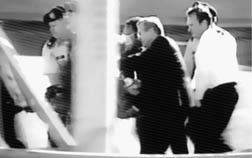At 9:36, Rumsfeld was aware there was an attack underway, but reportedly knew nothing of flight 77 heading straight for him. At that time, the Secretary was still in the Pentagon, now hanging out alone with Representative Cox. According to the U.K. Telegraph, the men were watching TV coverage of the smoking towers in Manhattan when the old man said “believe me, this isn't over yet. There's going to be another attack, and it could be us.” “The next minute, just seconds later,” Cox recalled in a press release, “Flight 77 hit the Pentagon.” Cox, for one, was left with no doubt who was in charge, and urged Americans to “listen and unite” behind the President and Rumsfeld. [3]
 |
Besides, near the ambulances would have been a dangerous place for the Defense Secretary to linger – as a self-described scholar of such things, he should have known that terrorists often conduct a second strike right when the rescue workers show up. While his security personnel were reportedly not pleased with this decision, Rumsfeld himself almost seemed to know that wasn’t part of the plan. He remained there for about fifteen minutes, by most accounts, until his security detail rushed him away.
Richard Clarke offers a different, more logical account. Clarke claims Rumsfeld was in on his Counter-terrorism conference when it started, between 9:10 and 9:25. As he entered the Video center with its bank of television screens, Clarke “could see people rushing into studios around the city,” including “Rumsfeld at Defense.” [4] Upon receiving word the Pentagon was hit by a plane, Clarke noted “I can still see Rumsfeld on the screen, so the whole building didn’t get hit.” [5]
But the 9/11 Commission, based on Rumsfeld’s testimony, concluded the secretary was in his office, getting his daily intelligence briefing as the attack began. After he was interrupted to be told a second plane had his in New York, “he resumed the briefing while awaiting more information. After the Pentagon was struck, Secretary Rumsfeld went to the parking lot to assist with rescue efforts.” [6] This leaves very little time either for Clarke’s teleconference or a meeting on “the future of terrorism and the Defense Department.” These accounts simply don’t add up.
But we know where he wasn’t. Some officials had already gone down to their battle stations in the NMCC bunker even before the Pentagon was hit (which was already more than a half-hour after everyone knew we were at war), and others joined them around 9:45 and after. By 10:00, Montague Winfield had taken the NMCC over again from Leidig, and would later state “for 30 minutes we couldn't find [Rumsfeld]. And just as we began to worry, he walked into the door” at 10:30. [7] Top-notch 9/11 researcher Paul Thompson wondered “shouldn't Rumsfeld have reported to the NMCC long before? For nearly an hour, apparently no one knew if he was killed in the Pentagon explosion or not.” [8] Up to this point, he actually knew very little of the response going on. The 9-11 Commission’s final report noted “Rumsfeld told us he was just gaining situational awareness when he spoke with the Vice President at 10:39.” [9] The last hostile aircraft had crashed thirty-six minutes earlier.
[1] CNN. “Where were You on 9-11?“ Larry King Weekend. September 7, 2002. Accessed November 12, 2004 at: http://www.cnn.com/TRANSCRIPTS/0209/07/lklw.00.html
[2] Cox, Christopher. “Chairman Cox's Statement on the Terrorist Attack on America.” Press Release. September 11, 2001. http://cox.house.gov/html/release.cfm?id=33
[3] Langley, William. “Revealed: what really went on during Bush's 'missing hours'” The Telegraph. December 16, 2004. http://www.telegraph.co.uk/news/main.jhtml? xml=%2Fnews%2F2001%2F12%2F16%2Fwbush16.xml
[4] Clarke, Richard. against All Enemies. Page 3.
[5] 37. Clarke. Pages 7-8.
[6] 9/11 Commission Final Report. Page 37.
[7] Thompson, Paul and the Center for Cooperative Research. The Terror Timeline. New York. Regan Books. 2004. Page 456.
[8] See [7]. Page 456.
[9] See [6]. Page 44



No comments:
Post a Comment